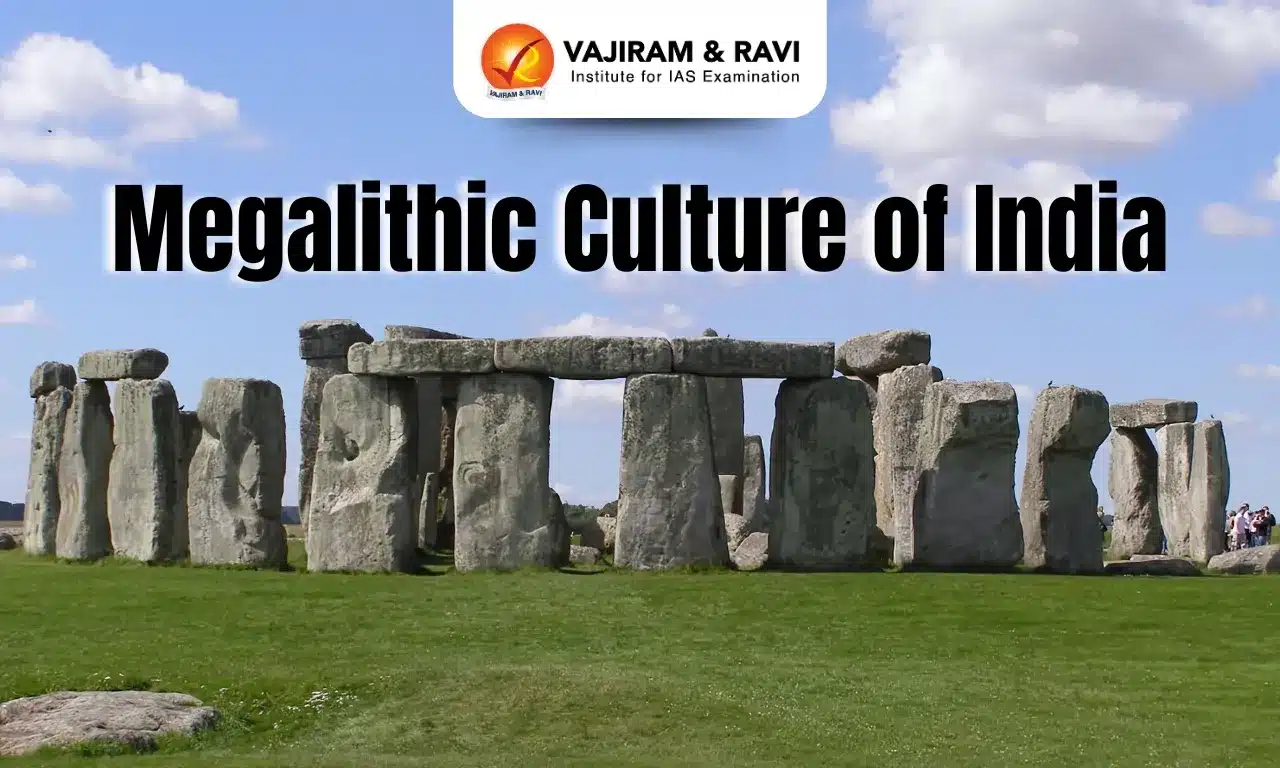Megalithic Culture of India: Megalith is a term that has been used to describe structures constructed by people from many cultures and geographical locations around the world. A megalith is a stone that is larger in size and has been used to construct a monument or a structure. These types of structures were predominantly constructed during the Neolithic period and persisted through the Chalcolithic Age, Bronze Age, and Iron Age.
In India, Megalithic Culture mainly belongs to the Iron Age (1500 BC–500 BC), with some exceptions, such as of Chalcolithic-Megalithic sites.
Types of Megaliths in India
The "Polylithic type" and the "Monolithic type" are two categories into which megalithic building types can be divided. The megalithic structure in the polylithic type is constructed from multiple stones. A monolithic structure is made up of just one stone. These structures are listed below.
Polylithic Type of Megaliths
| Types | Description |
Dolmen |
- This kind of megalith, which is typically supported by three or more upright stones and a sizable flat horizontal capstone, was made in a single chamber tomb. - In order to create a barrow, dolmens were typically covered with dirt or smaller stones. - Example: Clusters of Dolmen at Hire Benkal, Karnataka. |
|
Cairn |
- A man-made stone pile known as a "cairn" is frequently conical in shape. - They typically inhabit uplands, moorlands, mountaintops, or areas close to waterways. - Cairns are frequently built today as landmarks. They served as astronomical observatories or were built as monuments to the dead in ancient times. - These range from simple, unorganised stone piles to complex engineering feats. - Example: Ottiyambakkam Cairns |
|
Cromlech |
- The British term for prehistoric megalithic structures is cromlech, where crom stands for "bent" and llech for "flagstone." |
Cist |
- A cist or kist was used to encase the bodies of the dead. It might be connected to other monuments. - Example: Brahmagiri Cist, Karnataka. |
Monolithic Type of Megaliths
| Types | Description |
|
Menhir |
- A Menhir is a monolithic stone structure that is upright. - They come in a variety of sizes and irregular, square shapes that frequently taper upward. - Menhirs are widespread in Europe, Africa, and Asia, but they are most frequently found in Western Europe, particularly in Ireland and Great Britain. - Their origin is prehistoric. - Example: Ellarigudem, Telangana, and Several megaliths of Indian Tribes. |
|
Stone Circle |
- It is made up of standing stones arranged in a circle. - The placement of the stones can take the shape of a circle, ellipse, or even as a setting of four stones placed on a circle's arc. - Example: Stone Circle at Junapani, Madhya Pradesh. |
Megalithic Sites of India
The first excavated Megalithic site was the site of Adichanallur in the Tirunevelly district, Tamil Nadu. The excavation of Brahmagiri in Karnataka in 1975 helped us understand the culture of early South India. Following is the list of megalithic sites in India:
- Seraikala in Jharkhand
- Deodhoora in Almora district of Uttarakhand
- Koldihwa (Belan valley), Banda, Mirzapur, Prayagraj, and Varanasi districts of Uttar Pradesh (Chalcolithic materials)
- Thrissur and Kunnattur in Kerala
- Waztal, Burzahom and Brah in Kashmir
- Maski, Hallur, Chandravalli, Hire Benkal, Coorg, Heggadehalli and Brahmagiri in Karnataka
- Nagarjunakonda in Andhra Pradesh
- Junapani, Khapa, Mahurjhari, and Naikund are near Nagpur and a few sites in the Pune district in Maharashtra.
- Adichanallue, Sanur, Kodumanal and Perumbair in Tamil Nadu
Features of Megalithic Culture
The Megalithic culture is characterised by the use of large stone boulders in and around graves.
Burial Rituals of Megalithic Culture
Megalithic culture demonstrates that religious and superstitious beliefs predominated in megalithic communities. The elaborate items connected with the burials serve as clear evidence of this.
- Different burial traditions could indicate different social and ethnic groups, but so far, no fixed regional conventions regarding the orientation of the bodies or the graves have been observed.
- These buildings and the remains buried with the dead are evidence of the widely held notions of "afterlife" and "rebirth."
- These people may have only temporarily settled in one place before migrating in search of new resources when they were faced with a shortage due to the relatively transient construction of their habitation sites and homes.
- Horses were buried with the dead in the Vidarbha region, possibly after being sacrificed, but this may have been a local ethnic custom.
- Common characteristics of these burials include the presence of distinctive pots, i.e., red and black ware.
Social Organisation of Megalithic Culture
Only a very rough social structure of the Indian Megalithic people can be derived, and information on settlement patterns is essentially nonexistent.
- Division of labour: It appears that the communities may have included a variety of specialised groups, including goldsmiths, smiths, warriors, farmers, and carpenters.
- Economy: Primary agriculture, partly hunting
- Evidences of iron sickles and plough coulters
- Evidence of staples - Rice and ragi grains in the excavations at Kunnattur and Hallur, respectively.
- It is also shown by the hunting scenes in the Hire-Benkal rock paintings.
Ethnic Affinity and Origin of Megalithic Culture
It is unclear from where India's megalithic culture first emerged.
- Some scholars have said that the builders were Celts or Scythians, the Central Asian tribes.
- Others have made an effort to connect them to the Dravidians.
- In some tribes of India, the construction of megaliths is still a common practice (Gonds, Gadabas, Kurumbas, Mundas, Marias, Garos, Khasis, Nagas, Karbis, etc.).
- The skeletal remains found, especially from Brahmagiri, Yeleswaram, and Adichanallar, show that people were of mixed racial type.
Other Features of Megalithic Culture
Graves have provided evidence of animal bones, iron objects, pottery, ornaments, beads, etc.
- Villages were common among the Megalithic people.
- Megalithic people cultivated rice, wheat, ragi and domesticated animals like donkeys and buffalo.
- The discovery of iron objects in megalithic graves suggests an association with the Iron Age.
- Different types of pottery, including high-quality red and black pottery, are associated with the Megalithic culture.
- Some settlements have revealed pottery and Roman coins.
- Iron weapons, horse equipment, skeletons, and gold and silver ornaments are commonly found in these burials.
- Megalithic tombs, particularly in the Deccan region, have provided valuable information about the Iron Age.
Megalithic Culture of South India
Since the graves at South Indian sites are mostly megalithic in nature, the cultures are traditionally known as ‘Megalithic Culture’. In the pre-existing cultural backdrop of the area, the Megalithic builders appear completely exotic.
- West Asia, the traditional homeland of Chalcolithic culture, does not show the practice of Megalithic burials and hence cannot be considered as the source of dispersal of the iron using megalithic builders.
- Instead, sarcophagi and cist graves from the Iron Age can be seen along the coasts of South Arabia and the Levant. They probably came by sea route to enter Deccan India.
- Apparently, these people did not create any urban settlements, the likes of which we have witnessed in the Harappan period or during the phase of second urbanisation in the Ganga Valley.
- In remote, gipsy-like tent settlements, the megalithic builders may have kept horses for breeding and grazing in order to trade them with the newly emerging political centres in the middle Ganga valley.
- Given how self-centred the Megalithic Iron Age in Deccan remained, it did not require much effort for the northern centres of power to establish their dominance in this area over the course of the next 500–600 years.
Features of Megalithic Culture of South India
Following is brief information on the Iron Age Megalithic types of South India.
- Types of megaliths in the South:
- Large urns: Large urns with bones collected from previously excarnated dead bodies in them. These urns are stored with other burial equipment in a pit. After the pit has been covered, it can be located using a circular stone demarcation.
- Cists: Cists are constructed from stone slabs and occasionally have a similar flat stone placed on top of them. These are sometimes equipped with portholes curved out on one of the chamber wall slabs.
- Legged urn: Another significant design element of these Megaliths is the legged urn or sarcophagi, which were used to encase the body before actual burial.
- Chamber burial: The body has occasionally been placed inside chambers that have been cut out of the compact lateritic floor.
- Arrangement of the burials:
- The manner of disposing of the dead in the region of the Megalithic Cultures exhibits numerous variations.
- Each type of burial system has a unique arrangement of megaliths on the ground to mark the grave.
- Megalithic burials with iron have been found mainly in the Deccan part of South India.
- Black and Red Pottery: Black-and-red ware was the main pottery tradition of the Deccan Iron Age sites.
- The pottery types include carinated vessels, bowls with pedestals, and spouted dishes. A conical-shaped lid is often provided with a loop on the top.
- Flat axes with crossed straps, sickles, tripods, tridents, spearheads, lamps, multiple lamp hangers, and arrowheads are among the iron tools found at all megalithic sites.
Iron Age in India
The Late Harappan culture was succeeded in the Indian subcontinent by the Iron Age culture. The Iron Age in India marks the beginning of ancient history due to the start of literature (Vedas, Upanishads, and others) contributed by archaeological evidence.
- Division and Timeline: The main divisions of the Iron Age in India are:
- Painted Grey Ware (PGW) culture (1100–350 BC) and
- Northern Black Polished Ware (NBPW) culture (700–200 BC).
- Ashoka’s rule in the rest of India and the beginning of the Sangam age in the South mark the end of the Iron Age culture in India. After that, not a single metal/material has decided the fate of the society; rather, it has been the combination of various materials.
- Iron Age in Ganga Valley:
- Iron technology: The use of Iron was required for the formation of civilisation in the Ganga plains, as the forests were thick. It was needed because culture centres around the Indus and Ghaggar river systems were being deserted. Hence, the second urbanisation required both - Iron and the Ganga plains (middle and lower).
- Staples: Rice and barley
- A large evidence of pottery and terracotta figures.
- Pottery: Coarse with applique bands with fingertip impressions
- Iron Age in the West of Indus (1100 BC to 900 BC): There has been evidence of iron also in the erstwhile Harappan sites.
- The complex is called Gandhara sites.
- Charsada, Taxila and Timargarha were some important sites.
- Pottery: Red-burned pottery traditions.
- Iron Age in the South:
- Unlike the North, the Iron Age in the South is generally known entirely from the perspective of burials, i.e Megalithic Culture, despite the Iron played a major role in shaping the lives of the people.
- The earliest sites in South India are Hallur (Karnataka) and Adichanallur of Tirunelveli district (Tamil Nadu) around 1000 BC.
- Features are already discussed above (in the Megalithic Culture of South India).
- Painted Grey Ware (PGW) culture (continued from the Chalcolithic culture):
- Feature of both the Chalcolithic cultures and the Iron Age culture of Ganga plains.
- In the Ganga plains, it was developed around 1000 BC to 600 BC, probably in the Later Vedic period.
- Contemporary to Megalithic Cultures, the successor of the Black and red ware culture, and succeeded by NBPW in around 600 BC.
- Named after the style of pottery tradition, it was found first at Ahichhatra (Bareilly, Uttar Pradesh), popularised due to Hastinapura excavations.
- This culture was the first to effective and comprehensive utilisation of iron in India.
- Locations in the Ganga Plain (Iron Age sites) are the Indo-Gangetic Divide and the upper Ganga-Yamuna doab (ancient Aryavarta and Madhyadesa).
- Main staples: Rice and wheat
- Dwellings: Houses (huts) made of wattle and daub
- Pottery: Produced from clay, manufactured on wheels, by applying a thin slip on both surfaces and then baked at 600 degrees Celsius. Shapes were various, such as geometric patterns (dots, lines, swastikas, etc.) as well as naturalistic patterns (flowers, sun, etc.).
- Horse: They were also the first to domesticate horses (definite evidence).
Northern Black Polished Ware Culture (2nd Urbanisation)
NBPW Culture in India is an Iron Age Culture that replaced the Painted Grey Ware Culture in the Ganga Valley with the extensive use of iron technology.
- Location: The culture was developed in the Middle and Lower Ganga plains when Aryans migrated eastwards along the Ganga river system.
- Timeline: Developed around and after 700 BC, till Ashoka’s reign.
- Second urbanisation: Harappan culture (called the first urbanisation period), marked by fortification of cities and capitals of the Janapadas and Mahajanapadas.
- Pottery: The period is named after the distinctive style of pottery called Northern Black Polished Ware.
- Economy and polity: The development of Agriculture due to the use of iron tools led to the establishment of Janapadas and, later, Mahajanapadas around 600 BC. Magadha emerged as a powerful empire, especially under the Mauryans.
- Culture and religion:
- Hinduism was well established, and the composition of various texts, including Ramayana, was completed.
- The emergence of Buddhism and Jainism took place.
- Coins: Punch-marked coins appeared in this period.
- Script and language: Brahmi was the script of this region and time period, and Pali (mainly) and Prakrit were the languages of the masses.
| Other Related Posts | |
| Prehistoric Period | Indus Valley Civilization Sites |
| Chalcolithic Age | Rakhigarhi |
| Megalithic Culture | Lothal |
| Town Planning of Harappan Civilization | Kalibangan |
Last updated on November, 2025
→ Check out the latest UPSC Syllabus 2026 here.
→ Join Vajiram & Ravi’s Interview Guidance Programme for expert help to crack your final UPSC stage.
→ UPSC Mains Result 2025 is now out.
→ UPSC Notification 2026 is scheduled to be released on January 14, 2026.
→ UPSC Calendar 2026 is released on 15th May, 2025.
→ The UPSC Vacancy 2025 were released 1129, out of which 979 were for UPSC CSE and remaining 150 are for UPSC IFoS.
→ UPSC Prelims 2026 will be conducted on 24th May, 2026 & UPSC Mains 2026 will be conducted on 21st August 2026.
→ The UPSC Selection Process is of 3 stages-Prelims, Mains and Interview.
→ UPSC Result 2024 is released with latest UPSC Marksheet 2024. Check Now!
→ UPSC Prelims Result 2025 is out now for the CSE held on 25 May 2025.
→ UPSC Toppers List 2024 is released now. Shakti Dubey is UPSC AIR 1 2024 Topper.
→ UPSC Prelims Question Paper 2025 and Unofficial Prelims Answer Key 2025 are available now.
→ UPSC Mains Question Paper 2025 is out for Essay, GS 1, 2, 3 & GS 4.
→ UPSC Mains Indian Language Question Paper 2025 is now out.
→ UPSC Mains Optional Question Paper 2025 is now out.
→ Also check Best IAS Coaching in Delhi






















